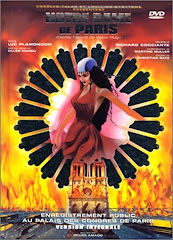1.
 Do you see triangles? How many?
Do you see triangles? How many?2.
Which inner dot appears bigger? Right or left?
3.
 Are the horizontal lines parallel?
Are the horizontal lines parallel?
· In the first image- the red one- the brain fills in the missing lines and completes the triangles- in fact there are none.
· In the second- the blue one- the brain is tricked into thinking the dot surrounded by the small dots is larger than the dot surrounded by the larger dots. In fact, they are he same size.
· In the third- the horizontal lines appear to be rising and falling, but are actually parallel.
In addition to these we discussed the MagicEye 3D images and how to get your eyes to see these. Many people have reported that they cannot see the images. However, after class, we were able to help a few more see the image.
This is the way to focus to see the MagicEye 3D images:
With the parallel viewing method (a.k.a. the divergence or Magic Eye method), the lines of sight of your eyes move outward toward parallel and meet in the distance at a point well behind and beyond the image. That's why it's called parallel viewing. When you parallel-view, the muscles inside your eye that control the focusing lens relax and lengthen.
Also, we discussed priming and how through exposure to certain stimuli, the brain is influenced to act in a certain way. Psychologist John Bargh and his colleagues showed that people who were unknowingly primed with words related to rudeness were much more likely to interrupt an experimenter’s private conversation than subjects who were primed with ‘polite’ words. Bargh also found that people who were covertly primed with words related to old age actually walked much slower after the experiment than people who were primed with non-age specific words.
When the priming is positive, the brain’s automatic activation can have a similarly significant effect on subsequent behavior. For instance, studies have shown that people primed with words related to ‘success’ subsequently perform much better on intelligence tasks.
Another topic touched on was perception of taste and how it is influenced by cost. Neuroscientist Hilke Plassman led a brain-scanning study, shortly to be published in the Proceedings of the National Academy of Sciences, where volunteers were asked to taste and rate five different wines, each individually priced.
What the volunteers didn't know was that there were only three different wines, and two of them were tasted twice: On one occasion it was described as costing $90 a bottle, on another as costing $10 a bottle.
The volunteers rated the 'more expensive' wine as significantly more likeable despite being identical to the 'cheaper' wine.
All in all, though people are pretty smart, we can be so easily tricked and fooled!












No comments:
Post a Comment